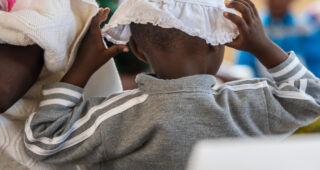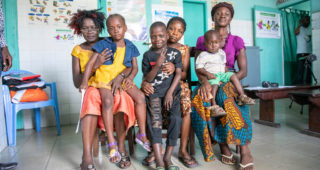Fight for What Counts
Overview
National actors engaged in the Global Fund to Fight AIDS, TB and Malaria (Global Fund) country funding request process have the opportunity to call for increased attention to and inclusion of pediatric HIV and TB interventions through the 2023–2025 allocation cycle. The Elizabeth Glaser Pediatric AIDS Foundation (EGPAF) developed this brief for supporting advocates, technical experts, and other national actors in advocating for the inclusion of pediatric HIV and tuberculosis (TB) within the upcoming Global Fund funding request process.
About the Checklists
Pediatric HIV Checklist for Global Fund Applications Review
The purpose of the checklist is to provide a summary of key elements, activities, and interventions related to pediatric HIV services (0-15-years-old) and prevention of mother-to-child transmission of HIV (PMTCT). These should be considered for inclusion in Global Fund country proposals to strengthen programming that addresses HIV and AIDS in children and contribute to the elimination of vertical transmission of HIV.
Checklist for Activities and Interventions to be Included in Global Fund Proposals for Strengthening the Management of Tuberculosis in Children and Adolescents
The purpose of this checklist is to provide a list of key activities and interventions related to the prevention and management of tuberculosis (TB) in children and adolescents. These key activities and interventions should be considered for inclusion in Global Fund country proposals to strengthen programming for addressing TB in children and adolescents and for closing persistent policy-practice gaps.
The Global Fund: Building a More Equitable World
The HIV and TB responses fail to meet the needs of children
Despite years of high-level pledges for urgent action to eliminate vertical transmission of HIV and achieve an AIDS-free generation, children continue to experience some of the most serious HIV-related inequalities.
According to UNAIDS, in 2021, only 52% of children living with HIV gained access to treatment (compared to 76% of adults),1 and only 41% of children living with HIV had a suppressed viral load (compared to 70% of adults). In 2021, 160,000 children were newly infected with HIV. Almost 85% of new vertical infections occurred in sub-Saharan Africa. Progress in preventing vertical transmission has slowed, with only a 22% decline in new infections from 2016 to 2021.
Additionally, children have historically not been prioritized in the global TB response. Children represent 11% of the global TB burden and 14% of TB deaths each year. Moreover, around 60% of children with TB remain undiagnosed and untreated, and significant investment in improving pediatric diagnostics, treatment, and access to services still has not been made.
Ending AIDS and TB in children will require key actors to both recognize the inequalities faced by children in the HIV and TB responses and to act to address them. Prioritizing children living with and affected by HIV and TB means allocating sufficient budgets for effective prevention, testing, and treatment interventions at clinic and community levels, updated policies, sufficient stocks of the most effective tools, and data collection, all backed by strong political leadership and commitments. Proper data, effective interventions, investment, and attention are needed now to prioritize children living with and affected by HIV and TB. Increased efforts are needed to eliminate vertical transmission of HIV, syphilis, and hepatitis.
The Global Fund’s need to fight inequalities faced by children
The Global Fund 2023-2028 Strategy highlights the needs of reducing health inequities, including age-related disparities. In most countries, national strategic plans and Global Fund guidance open the door for more inclusive designs that meet the needs of children. The Global Fund modular framework includes eligible interventions for children and pregnant women, with specific modules and interventions for children and their mothers.
Global Fund’s grants have not prioritized substantial investments in children’s health over the past several years, and children continue to remain a low priority in Global Fund’s grants and agenda. Based on past Technical Review Panel (TRP) reports, interventions for pediatric HIV were not present in funding requests in countries where there was a known need. Vertical HIV transmission-related activities—such as partner testing and early infant diagnosis, especially at point-of-care—are not adequately prioritized. Interventions addressing childhood TB were either not planned, too small in scale, or lacking the necessary ambition to close the detection gap. Moreover, the TRP states that there were no funding requests found in the 2020-2022 allocation cycle to address TB in adolescents.
A historic chance to create lasting change for children living with HIV and TB
With existing knowhow, innovative tools, and experience from partners, Global Fund Grant Cycle 7 is a historic opportunity to help end AIDS and TB in children. For countries to seize this moment to full effect, they must elevate and advocate for the needs of children.
During this funding cycle, Global Fund’s country grants should prioritize allocation of sufficient funds to all relevant budget lines related to children. For this to happen, pediatric priorities must be included in each of the in-country discussions, debates, writing, and review of the country proposals so that prioritized services for children materialize in the final budget and grant agreement. Past years’ processes have shown us that—without regular interventions to promote and protect children’s health and rights—they are often neglected in favor of multiple other conflicting priorities. Without explicit mention of children’s needs in the budget, there is no guarantee that broader budgets will provide the specific services, interventions, and commodities they need. We therefore need strong and proactive engagement with Country Coordinating Mechanism (CCM) members, government, civil society, and technical agencies to ensure children are not forgotten in country dialogue, drafting processes, and decision-making platforms.
Bringing children’s needs to the grant development process
It is critical that partners working on pediatrics engage with the Global Fund national process to bring children’s needs into the grant development process. For example:
- Ensure the HIV/AIDS National Strategic Plan includes pediatric AIDS and all relevant interventions for an effective pediatric response and that the country has a good analysis of the programmatic and funding gaps to fill the needs.
- Based on evidence, country experience, and country analysis, identify critical interventions for inclusion in the country grant. Consider using the Global Fund Modular Framework to align with the Global Fund eligible interventions.
- Engage with key national platforms and groups to inform the country grant, in particular with:
- CCMs
- Communities and civil society (for example, like the Kenya Civil Society Children Priority Charter, the national charters of civil society and community organizations can inform country grants with their own analysis and good practices and advocate for innovative models of care to be considered)
- National technical working groups, writing team, and technical agencies
- Engage in the country review process to address comments provided by the TRP and ensure that pediatric interventions and budgets remain as part
of the country grant - Discuss the needs for technical assistance with relevant country actors to ensure effective implementation of the country grant
- For more information, visit the Global Fund Applicant Handbook
1 In Danger: UNAIDS Global AIDS Update 2022. Geneva: Joint United Nations Programme on HIV/AIDS; 2022.
Photo: Joeli Mtoto Phabiani accompanied his mother, Rose Michaeli Mushy, to the mother support group. Rose is a leader in the group. At the Kibosho Hospital in Moshi (Kilimanjaro Region), Tanzania, a group of mothers get together to discuss issues related to living with HIV, including disclosure, adherence to ARVs, and psychosocial support. Photo by Eric Bond / EGPAF 2020.
Global
Policy & Advocacy



